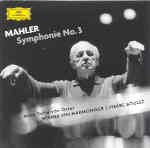Having seen Pierre Boulez’s very uncompelling live performance of this symphony with the Vienna Philharmonic, this broadly similar but in most respects vastly superior version (both playing and conducting) comes as a pleasant surprise. Boulez’s principal weakness–a certain unyielding stiffness of tempo à la Horenstein–also is a source of strength. For example, he doesn’t manage the accelerando into the first movement development’s “Southern storm” episode, but (unlike Horenstein) the steady tempo allows his players to emphasize the march-rhythms and bright dabs of orchestral color.
It also has to be said that the Vienna Philharmonic never has played this piece wholly successfully, being historically unwilling to indulge in the shocking extremes of contrast that Mahler demands, and also (in the brass department) simply too tired by the symphony’s end to sustain the necessary intensity of expression. Here however Boulez’s relatively swift tempo for the finale’s opening theme allows the trumpets to manage an exquisite legato when it returns triple-piano as a heavenly chorale toward the movement’s close. Those who feel that those dreamy posthorn solos in the scherzo drag on endlessly also will appreciate Boulez’s refusal to relax the tempo as much as Mahler most likely had in mind.
The one place where Boulez’s approach doesn’t work is in the charming second movement. “Charm”, in any case, never has featured prominently in Boulez’s unsentimental interpretive arsenal, and here his refusal to speed up in the contrasting episodes really does weigh the music down. Proponents of the “one tempo fits all” school claim that an unyieldingly stiff beat somehow emphasizes the music’s “architectural” or “symphonic” elements, which makes about as much sense as claiming that making all doors and windows the same size enhances the physical integrity of a building. It’s nonsense. This single lapse aside, the remainder of the symphony goes swimmingly, with Anne Sophie von Otter a marvelous soloist in the fourth movement, an aptly perky account of the choral fifth, and as previously suggested, a flowing (but serene) finale that at a bit more than 22 minutes is much better paced on disc that it was live.
Sonically the recording is mostly excellent, capturing the unique Viennese sonority–the warm strings and horn-heavy brass–but also giving the winds a good bit of attention (and Boulez really gets them to play out for a change, especially in those marvelously vulgar episodes in the first movement’s development section). There’s a strange momentary shift in level and perspective in the offstage posthorn toward the end of the scherzo, a tiny glitch that should have been corrected, but otherwise this stands as an impressive and wholly recommendable account of the symphony that will please both Boulez’s many admirers and Mahlerians generally. [4/14/2003]
































